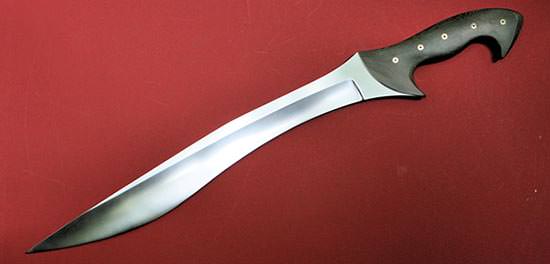
Dory (δόρυ)
The dory was the primary weapon of the ancient Hellenes. It was a spear about 3 meters in length consisting of a wood shaft with an iron tip. It was wielded single-handedly so the user could hold a shield in the other hand. The dory enabled the hoplite (soldier) to keep an enemy at a distance and was effective in phalanx (shield-wall) formation, allowing the first two lines to attack.
Xiphos

The primary weapon of ancient Hellenes was the dory, but if it broke they used a short single hand sword known as a Xiphos. The Xiphos had a double-edged blade that rarely measured longer than 20 inches which made it useful in close range combat. It was more martially versatile than the other prominent sword, the single edged Kopis.
 Kopis (κοπίς)
Kopis (κοπίς)
Homeros mentions the makhaira, but as a domestic knife of no great size. In period texts the term has a variety of meanings, and can refer to virtually any knife or sword, even a surgeon's scalpel, but in a martial context it frequently refers to a type of one-edged sword; a sword designed primarily to cut rather than thrust. Some modern scholars distinguish the makhaira from the kopis (an ancient term of similar meaning) based on whether the blade is forward curved (kopis), or not (makhaira).
Introduced by Alexander’s father, Philip II of Macedon, Sarissa was a 4 to 7 meters long spear which was used instead of the dory. It was made of tough cornel wood and weighed around 5 kilograms. The sarissa was considerably longer than its predecessor and this made it very effective in the Macedonian phalanx which was considered invulnerable from the front and could be only defeated if the formation was broken. Invention of Sarissa greatly helped Philip II and his son Alexander the Great in their conquests.


No comments:
Post a Comment